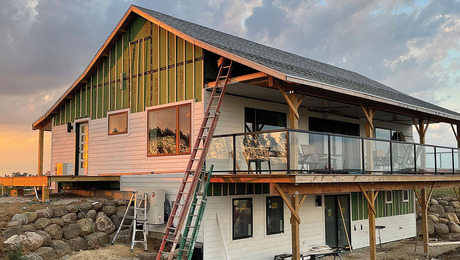I got some very pretty 4×8 fir with live-edge to put on my fireplace mantels. The potential problem is that they aren’t dry (in fact 30% MC according to my Wagner meter) and I really would prefer not to hide them away for a few years to air-dry before using them. The house is heated mostly by heatpump forced-air so the fireplace is rarely used – and is a propane insert anyway – so we’re not talking of intermittent high heat affecting the wood. And in theory spring and summer are on the way even up here in the great white north-west.
I’m thinking it might be a good idea to hollow out the back of the chunks and leave an inch or so of top, front and end (maybe more at the ends?) to relieve a portion of the drying stresses. I can easily have them sitting on small spacers to let air circulate gently, and I will give the ends a good coat of penetrating sealer. Has anyone else any experience with doing this sort of thing? Or is it such a dumb idea no-one will admit to it ? ![]()















Replies
You're talking about
reaming out most of the wood, from the back, so that it will dry and hopefully stabilize more quickly? That seems like it could easily allow a lot of distortion that won't occur if you let the wood dry normally. You can either air dry it or take it to someone with a kiln. After it's dry, cut it to finished size.
It's an intersting problem really; a thick chunk will dry at the outer surfaces and try to distort but be resisted somewhat by the deeper core. That might keep it straight or might cause really bad splitting. Making a partial box to fake a large chunk might have fewer stresses because of the easier drying of thinner material but has a bit less to resist distortion. Which is actually going to end up in the better condition?
In most cases, I'd guess...
timrowledge wrote:
Which is actually going to end up in the better condition?
... a piece that's milled oversize, air dried slowly, then milled to finish size and installed. But you could still call around to some small sawmills, find out who operates a kiln, then ask if they'll throw you piece in with some of theirs. It should be affordable, and fast. Then you can just have at it!
There are stablizing sealers you can put on the wood that reduce warping and splitting. Sold to people with DIY sawmills, etc.
I'm with Dan on this one - you want to seal it so moisture is removed very slowly. With thicker slabs of green wood you'll have terri ble checking, cracking, twists, cups, bows and lord only knows what.
The sealers are often waxy so that may not be the best for your live edge, but if you don't seal it there won't be much worth saving.
Depends on grain orientation - plain sawn, quarter sawn, near heart, etc...
If quarter sawn, a saw kerf the full length >1/2 depth (of width) will help prevent splitting.
Other cuts, can go any which way, literally.
Install a couple of decorative or inconspicuous brackets on the wall above the fireplace. Place the wet plank there but first seal the end grain (it should have been done long ago, really) first. I've used Anchorseal before, but any latex paint will work OK. Let it sit there for a year or so. Enjoy looking at it. Plan out cutting and finishing it when its ready. Use it to hold xmas cards. After drying, do what you will with it.
No need for inconspicuous brackets in this case. I'll just let them sit there for now and see what happens. There's always glue...
The keep it simple solution is often the best.
Another suggestion: Tack a piece of thin ply across the opening between the fir chunks, and paint it to match the walls. This will both look better and keep knick-knacks from escaping into the inner void of the fireplace/heater.
Ooh ya; there is actually a strip of backerboard and some tiles to match the rest of the fireplace still to go in there. I've been a tad busy this week making a door and trim for the broom closet in the mudroom. This was just a couple of planks of rough 2x8 at the beginning of the week -